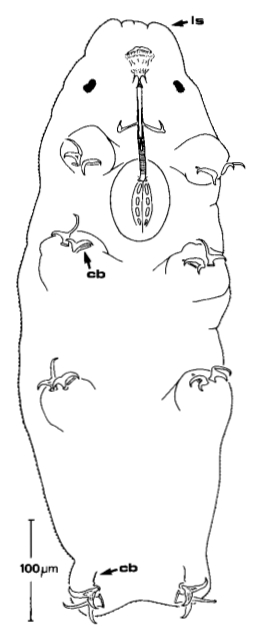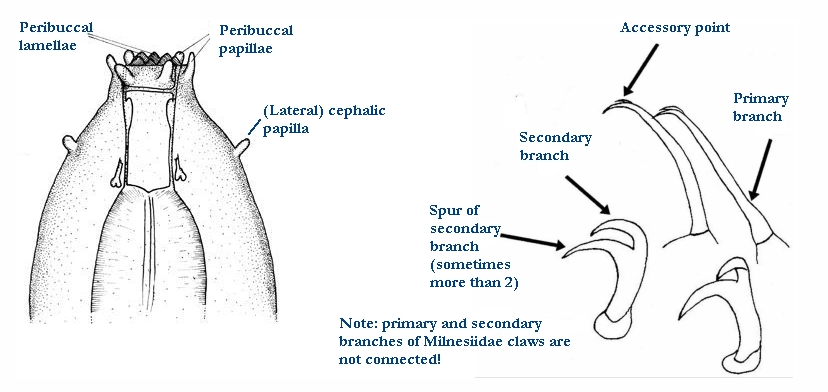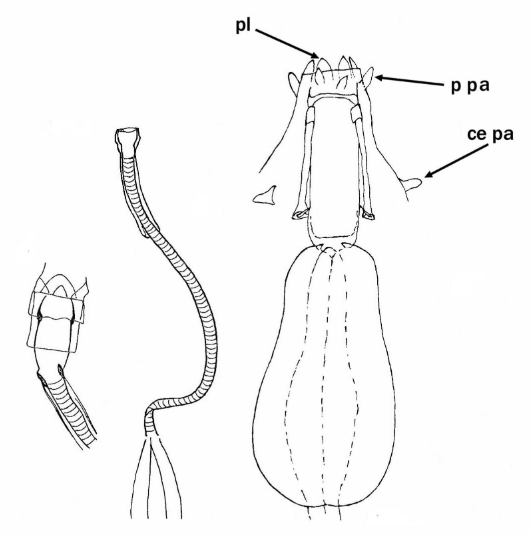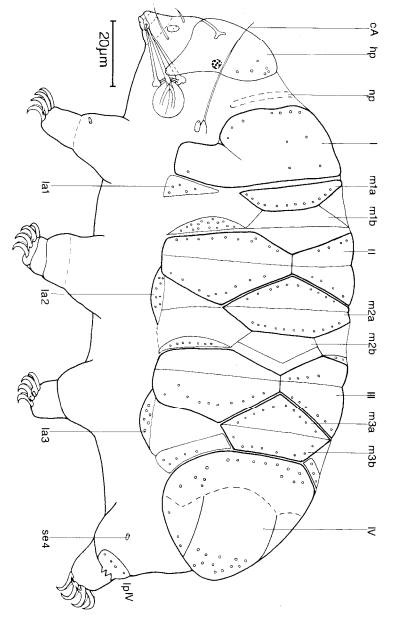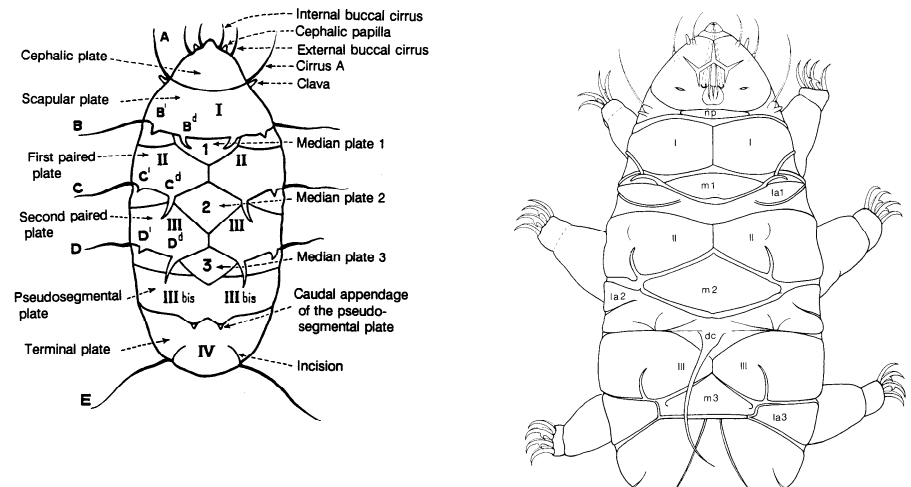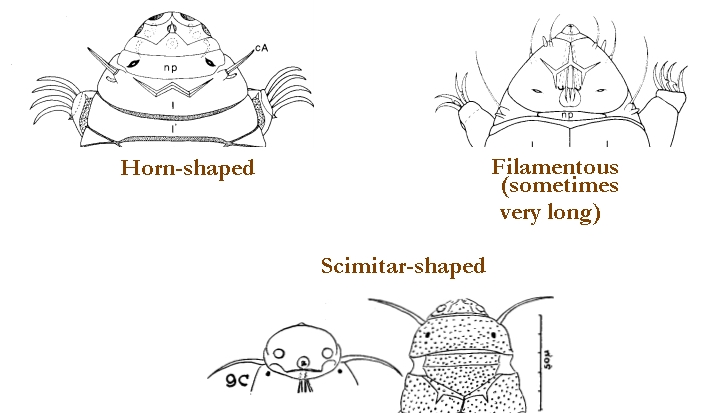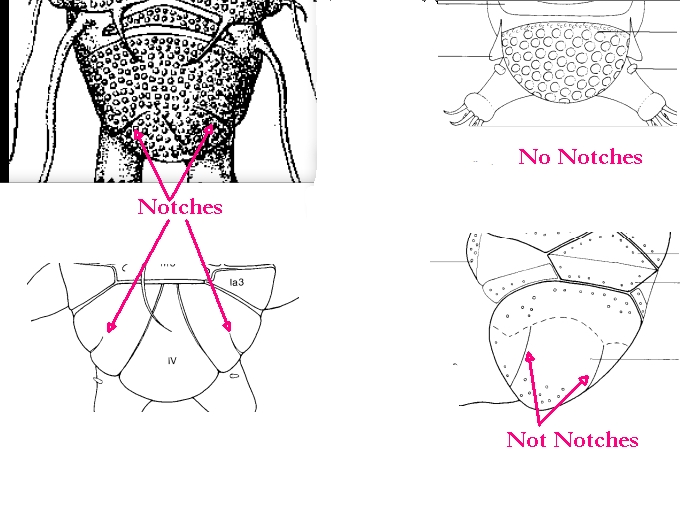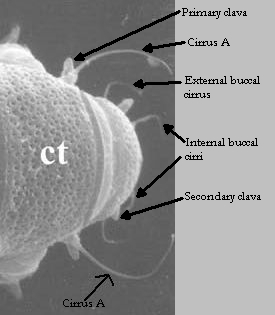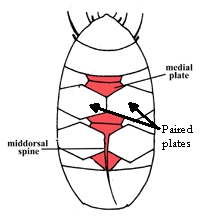Genus Ramazzottius
Hypsibioidea from Pilato 1969 in Marley et al. 2011: “Parachela; claws asymmetrical (2121); Hypsibius-type claw pairs; AISM hooked (or, if the buccal tube is elongated, AISM can be broad ridges).”
Hypsibioidea from Bertolani et al. 2014: “Double claws asymmetrical with respect to the median plane of the leg (2121), the external (or posterior) claw often with flexible main branch; double claws different in size and shape on the same leg (Hypsibius and Ramazzottius type, or modified), or very reduced in size (Calohypsibius and Microhypsibius type); buccal tube often very narrow”
Hypsibioidea from Gąsiorek et al. 2018: “Eutardigrades with asymmetrical claws (2-1-2-1) and pseudolunulae at claw bases or without any cuticular structures under the basal parts. Hooked or broad-ridged apophyses for the insertion of the stylet muscles. Herbivorous or microbivorous (Guidetti et al. 2012).”
Ramazzottiidae from Marley et al. 2011: “Hypsibioidea. The AISM comprises asymmetric, dissimilar dorsal and ventral ‘blunt hooks’. Claw pairs asymmetric (2121), external claw primary branch joins the secondary claw and basal section with flexible junction; primary branch may be very long and slender; the internal claw branches and basal section unified into a single rigid element. Eggs have a sculptured chorion and are deposited free in the environment.”
Ramazzottiidae from Bertolani et al. 2014: “Double claws different in shape and size on the same leg, the external (or posterior) claw with the primary branch connected to basal tract with an evident, thin, flexible tract (Ramazzottius or oberhaeuseri type, or modified), or completely disconnected. Eggs laid freely and with ornamented shell.”
Genus description from Binda & Pilato 1986: “Hypsibiidae con unghie di tipo oberhaeuseri; le due diplounghie di ciascuna zampa molto diverse fra loro; apparato bucco-faringeo costruito secondo il modello Hypsibius con tubo boccale rigido e apofisi per l’inserzione dei muscoli degli stiletti ‘ad uncino smussato’ e asimmetriche rispetto al piano frontale; è presente un organo sensoriale ellittico dorsolaterale sul capo; uova deposte libere e col guscio provvisto di sporgenze; lamelle periboccali assenti, le lunule possono essere presenti anche se molto piccole. Nelle specie finora note il bulbo faringeo contiene le apofisi faringee e soltanto 2 macroplacoidi; finora mai segnalati il microplacoide e il septulum.”
Translated: “Hypsibiidae with oberhaeuseri claws; the two double-claws of each leg very different from each other; bucco-pharyngeal apparatus constructed according to the Hypsibius model with a rigid buccal tube and apophyses for the insertion of the muscles of the stylets ‘blunted’ and asymmetric with respect to the frontal plane; there is a dorsolateral elliptic sensory organ on the head; eggs laid free and with the shell provided with protrusions; peribuccal lamellae absent, the lunulae may be present although very small. In the species known so far, the pharyngeal bulb contains the pharyngeal apophyses and only 2 macroplacoids; so far the microplacoid and the septulum were never reported.”
Alberta:
Ramazzottius sp.
Canada:
Ramazzottius baumanni (Ramazzotti, 1962) rectangular megap
Ramazzottius oberhaeuseri (Doyère, 1840) macroplac. similar in size (or 1st slightly longer)
North America / Nearctic:
belubellus n sp long triangular spines
Other:
Ramazzottius affinis Bertolani, Guidetti & Rebecchi, 1994 only 5-6 transverse bands of pigmented granules/tubercles
Ramazzottius andreevi Biserov, 1997/98 macroplac not constricted
Ramazzottius anomalus (Ramazzotti, 1962) smooth (despite pigmented bands)
Ramazzottius bunikowskae Kaczmarek, Michalczyk & Diduszko, 2006 macroplac. short, unconstricted & barely longer than wide. Transverse bands of tubercles.
Ramazzottius cataphractus (Maucci, 1974) no accessory pt.
Ramazzottius caucasicus Biserov, 1997/98 only weak constrictions for macroplac, and no cuticular sculpture, crests on both sides of external claws, small smooth poorly-visible lunules
Ramazzottius edmondabouti Séméria, 1993 shorter, beige, sculpture (platelets) only in every 2nd band, description poor re: macropl.
Ramazzottius horningi Binda & Pilato, 1994 shorter, with sculpture not only in bands though less evident. Thin but clearly visible lunules. Macroplacoids “granules”
Ramazzottius ljudmilae Biserov, 1997/98 macroplac. more similar in size, unconstricted
Ramazzottius montivagus (Dastych, 1983) claws much stumpier
Ramazzottius nivalis Dastych, 2006 primary branches increasing in size posteriorly (50% from I to IV). 1st macroplac. only slightly longer than 2nd. Egg distinctive. Very long primary on outer claw only resembles R. ljudmilae & R. cataphractus, need morphometrics or eggs for former, but AP distinguishes latter (this one has them on primaries). Granulated.
Ramazzottius novemcinctus (Marcus, 1936) cuticle smooth, dubious sp., secondary longer than primary! 9 pigmented bands.
Ramazzottius rupeus Biserov, 1999 oberhaeuseri pattern, more prominent lunules on all legs, unconstricted macroplacoids
Ramazzottius saltensis (Claps & Rossi, 1984) macrop. equal
Ramazzottius semisculptus Pilato & Rebecchi, 1992 macrop. not constricted, no accessory pts. on inner claws
Ramazzottius subanomalus (Biserov, 1985) macropl. unconstricted
Ramazzottius szeptycki (Dastych, 1980) prominent tubercles
Ramazzottius theroni Dastych, 1993 sculpture over entire dorsal/lateral sides & legs
Ramazzottius thulini (Pilato, 1970) shorter. macropl. very similar & not constricted
Ramazzottius tribulosus Bertolani & Rebecchi, 1988 pt thickened all the way back from ss. macroplacoids stubby
Ramazzottius valaamis Biserov & Tumanov, 1993 granulations over all including all legs
Ramazzottius varieornatus Bertolani & Kinchin, 1993 2nd macrop. fairly long, much larger than ph. apo.? Not necessarily, judging by Kinchin 1996
Key from Biserov 1997/98. Missing: belubellus (long spines), bunikowskae (similar to caucasicus & tribulosus), nivalis (compare ljudmilae, cataphractus), novemcinctus (dubious, secondary instead of primary long), rupeus (compare horningi & semisculptus)
1.With small ocularspots 2
– No ocular spots, elliptical structures present only . _ 3
2. Sculpture comprised of hemispherical, polygonal thickenings (2.0-6.0 µm), without tubercles . . . . . . R.theroni Dastych,1993
– Sculpture comprised of tubercles, arranged impaired in rows . R. saltensis (Claps & Rossi, 1984)
3. Sculpture true tubercles, paired in rows . . . . . . . . _ …………….. R. szeptyckii (Dastych, 1980)
– Without true tubercles, sculpture, if present consisting of small (2.0-9.0 µm) hemispherical or polygonal thickenings or reticulations . . . . . . . . . . . . 4
4.Pt of outer claw of legs IV more than 100 . . . . . . 5
– Pt of outer claw of legs IV less than 100 . _ . . . . . 6
5. With accessory points on main branches of claws . R.ljudmilae n.sp.
– Without accessory points on main branches of claws . . . . . . . _ . . R. cataphractus (Maucci, 1974)
6. Outer claws long and slender, of typical oberhaeuseri-type 7
– Claws thick and stumpy .. . . . . . . . . . . . . .. R. montivagus (Dastych, 1983)
7. Internal diameter of buccal tube more than 2.5 µm. Animals with visible sculpture. Processes of eggs variable: some needle-like or slender and conical; other finger-like with rounded end; some filiform . _ _ . . . . R. varieornatus Bertolani & Kinchin, 1993
– Internal diameter of buccal tube less than 2.5 µm … 8
8. With sculpture on dorsal side of body, sometimes inconspicuous 9
– Animals without sculpture 17
9. Sculpture large, up to 8-9 µm per unit . . . . . . . 10
– Sculpture smaller, separate plates up to 3.8 µm each …11
10. Sculpture largest in region of legs III, dorsally and dorsolaterally covering all body surface. Macroplacoíds square . . . R. baumanni (Ramazzotti, 1962)
– Sculpture largest caudally, dorsally without sculpture on large areas. Macroplacoids oval . . . . . . . . . . . . . . . . . . . . . . . . R. edmondabouti Semeria, 1993
11. Eggs with hemispherical processes . . . _ . . . . . . 12
– Eggs with conical processes ……………. 13
12. Animals with well developed sculpture . . . . . . . . . R. thulini (Pilato, 1972)
– Sculpture always present but less developed _ . . _ _ _ _ _ _ _ _ _ _ _ _ _ _ _ _ _ _ R. oberhaeuseri (Doyère, 1840)
13. Pt of outer claw of legs IV less than 80. Claws of legs III shorter those of legs IV. Eggs with uniform processes … 14
– Pt of outer claw of legs IV 78.5-88.0. Claws of legs III as long as those of legs IV. Eggs with two types of processes . . . . . R. affinis Benolani et al., 1993
14. Egg processes slender and conical, 6.0-21.8 µm long … 15
– Egg conic processes smaller, 2.15-7.5 µm long _ 16
15. Egg surface between processes smooth, processes 7.7-9.6 µm long, adults with well developed sculpture . . . R. tribulosus Bertolaní & Rebecchi, 1988
– Egg surface between processes covered with small dots, processes 6.0-21.8 µm long, adults with poorly visible sculpture … R. horningi Binda & Pilato, 1994
16. Pt of outer claw of legs IV 64.3-76.8. Bases of egg processes jagged . . . . . . . . R. semisculptus Pilato & Rebecchi, 1992
– Pt of outer claw of legs IV 74.3-87.8. Bases of eggs processes smooth . . . . . . . . . . . . R. andreevi n.sp.
17. Egg processes filiform, 3.7-9.0 µm long. Pt stylet supports more than 61.0 . . . . . . . . . R. valaamis Biserov & Tumanov, 1993
– Egg processes conical. Pt stylet supports usually less than 61.0 … 18
18. Egg processes large and conical, up to 20 µm long; without dots on shell of eggs . R. caucasicus n.sp.
– Egg processes smaller, up to 12.0 µm long . . . . 19
19. Egg processes 5.0-12.0 µm long. Egg surface between processes covered with small dots. Only known from S. America … R. anomalus (Ramazzotti, 1962)
– Egg processes of 2.1-7.5 µm long. Egg surface smooth. Only known from Eastern Europe _ _ _ _ _ _ R. subanomalus (Biserov, 1985)
Citations :
Ramazzottius image from Dastych H. 2006. A new tardigrade species of the genus Ramazzottius Binda & Pilato 1986 (Tardigrada) from the nival zone of the Mont Blanc Massive (the Western Alps), with some morphometric remarks. Mitteilungen aus den Hamburgischen Zoologischen Museum und Institut. 103: 33-45.
“Parts” images from Pilato G, Binda MG. 2010. Definition of families, subfamilies, genera, and subgenera of the Eutardigrada, and keys to their identification. Zootaxa. 2404: 1-54.
Bertolani R, Guidetti R, Marchioro T, Altiero T, Rebecchi L, Cesari M. 2014. Phyloeny of Eutardigrada: New molecular data and their morphological support lead to the identification of new evolutionary lineages. Molecular Phylogenetics and Evolution. 76: 110-126.
Binda MG, Pilato G. 1986. Ramazzottius, nuovo genere di eutardigrado (Hypsibiidae). Animalia. 13: 159-166.
Gąsiorek P, Stec D, Morek W, Michalczyk Ł. 2018. An integrative redescription of Hypsibius dujardini (Doyère, 1840), the nominal taxon for Hypsibioidea (Tardigrada: Eutardigrada). Zootaxa. 4415 (1): 45-75.
Marley NJ, McInnes SJ, Sands CJ. 2011. Phylum Tardigrada: A re-evaluation of the Parachela. Zootaxa. 2819: 51-64.
Pilato G. 1969. Schema per una nuova sistemazione delle famiglie e dei generi degli Eutardigrada. Bollettino delle Sedute della Accademia Gioenia di Scienze Naturali in Catania, Series IV. 10 (277): 181-193.
